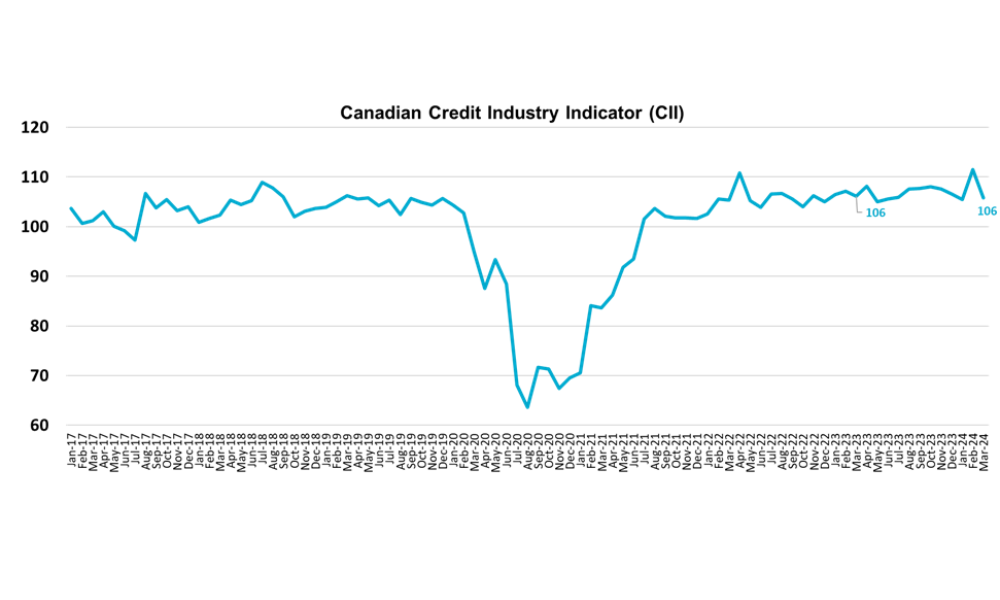Balances are rising along with minimum payments and delinquencies, TransUnion reports


Canada’s use of credit products is continuing to rise, with the cost of living among the key elements that has pushed total consumer debt to almost $2.4 trillion while delinquencies have increased.
A new report from TransUnion Canada shows that credit participation in the first quarter of 2024 gained 3.8% year-over-year with almost 32 million Canadians holding at least one credit product. Many people started the year already in debt and in despair according to previous research.
Driving this growth were people new to Canada who accounted for 11% of all new origination volumes after a 33% year-over-year increase. Perhaps more concerning, another key cohort driving growth was GenZ with a 30% year-over-year rise in outstanding balances including 18% for credit cards and 11% for personal loans.
Millennials recorded a 5% rise in credit participation and account for 27% of Canadian credit accounts, beating Boomers for the first time, and holding $911 billion in debt or around 38% of all debt.
“Inflationary pressures may lead consumers to turn to bankcards or personal loans to help make ends meet, and Millennials and Gen Z consumers are no exception,” said Matthew Fabian, director of financial services research and consulting at TransUnion Canada. “Lenders need to carefully monitor credit performance in the coming year, particularly among younger consumers and those at lower income levels who may be more vulnerable to the current economic strains of elevated inflation and interest rates. A portion of consumers in these segments are likely to still see some challenges despite anticipated interest rate relief later in the year.”
The higher interest payments many Canadians are making on their mortgages – which has kept many potential homebuyers on the sidelines - may be restricting their ability to make larger payments on other credit products.
For example, the share of credit card holders making only the minimum payment due has grown by 1.3% (up 8 bps year-over-year) meaning a rise in revolving balances.
“We have observed that when consumers are faced with mortgage payment shock, the impact on credit card delinquency is two to three times that of mortgage delinquency,” Fabian said. “Non-mortgage debt held by homeowners is now well above 2019 levels, with at least 50% of outstanding mortgages yet to be repriced.”
Delinquencies rise
For some Canadian credit consumers, TransUnion’s Credit Industry Insights Report suggests that the cost of living and their debt burden are already causing financial stress.
The percentage of consumer credit accounts that were 90+ days past due increased by 20 basis points in the first quarter of 2024 from a year earlier to reach 1.76%. Alberta had the highest rate of serious consumer-level delinquency (2.21%) followed by New Brunswick (2.16%) and Manitoba (2.11%). It was Ontario though that saw the largest increase (26 basis points) although its overall rate remains relatively low at 1.82%.
Credit cards saw the biggest spike in serious delinquencies, up 14bps to 0.91% followed by lines of credit (up 9bps to 0.28%), and both auto loans (up 4bps to 0.57%) and mortgages (up 4bps to 0.15%). Personal loans recorded a 2bps decline in serious delinquencies but had the highest rate at 1.33%.
There was also an 11% rise in accounts rolling forward into later stages of delinquency compared to a year earlier.
“Despite these rising delinquency levels, Canada’s commodity-producing provinces remain best positioned to weather growth headwinds,” said Fabian. “These regions generally experience more volatile economic conditions, given their additional dependency on commodity prices and seasonality. Cost of living increases are not uniform and impact regions differently across Canada. While we see delinquency rates rise faster in some areas, future economic growth and lower interest rates are expected to offset this in the long run.”



